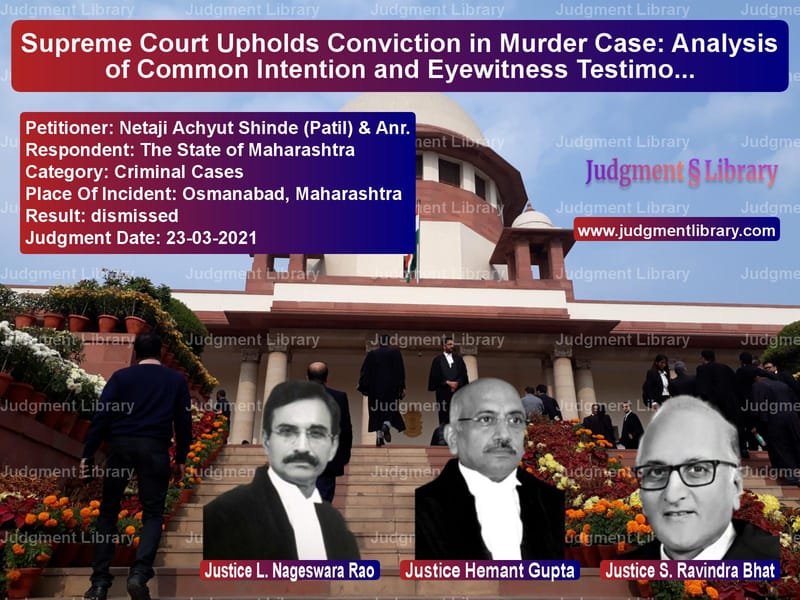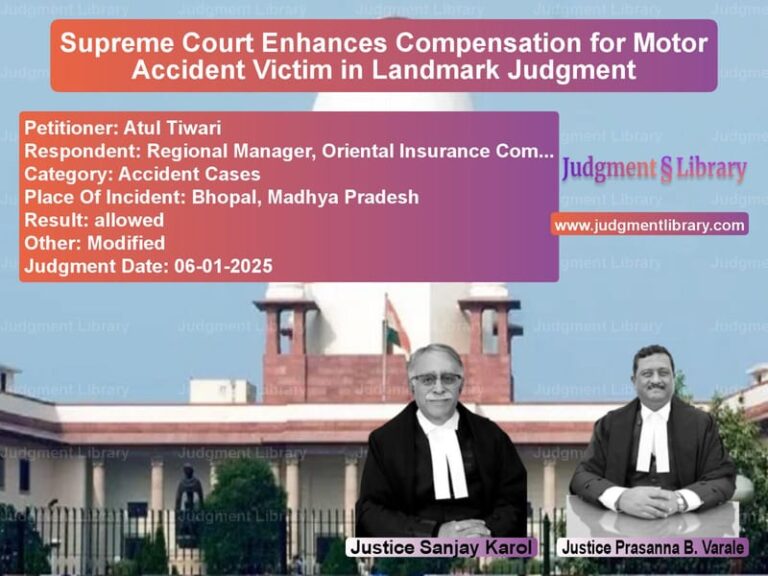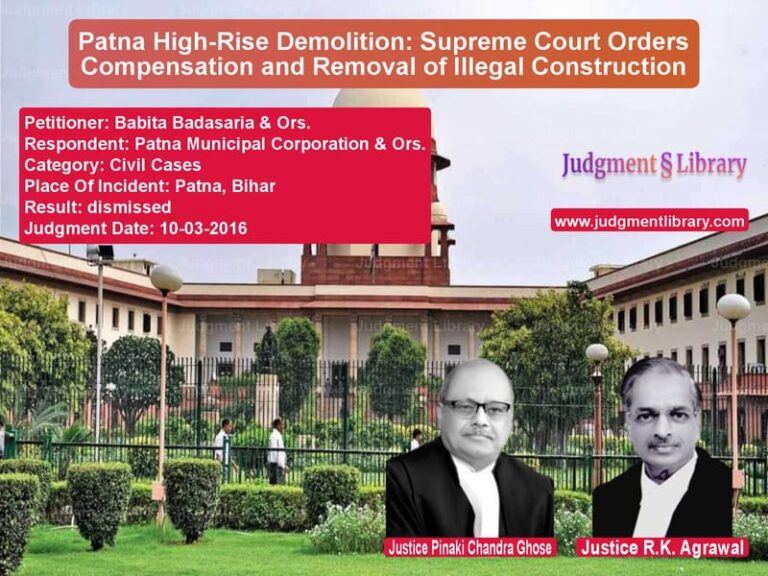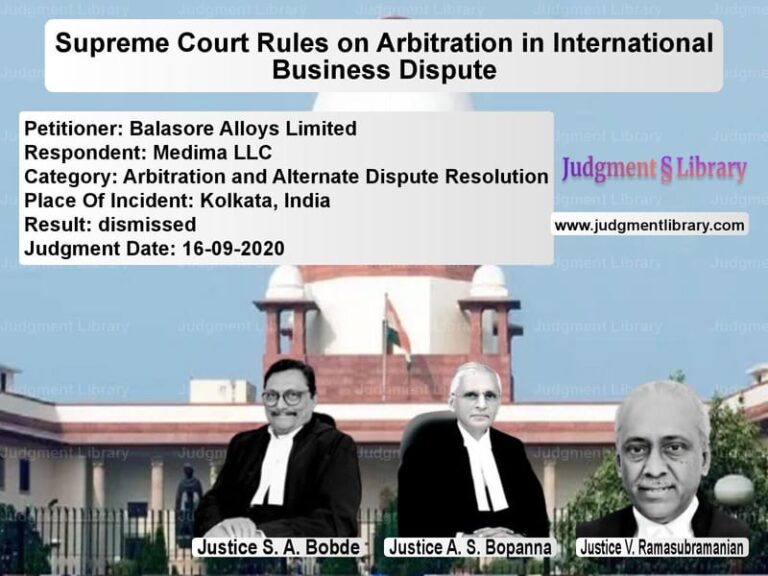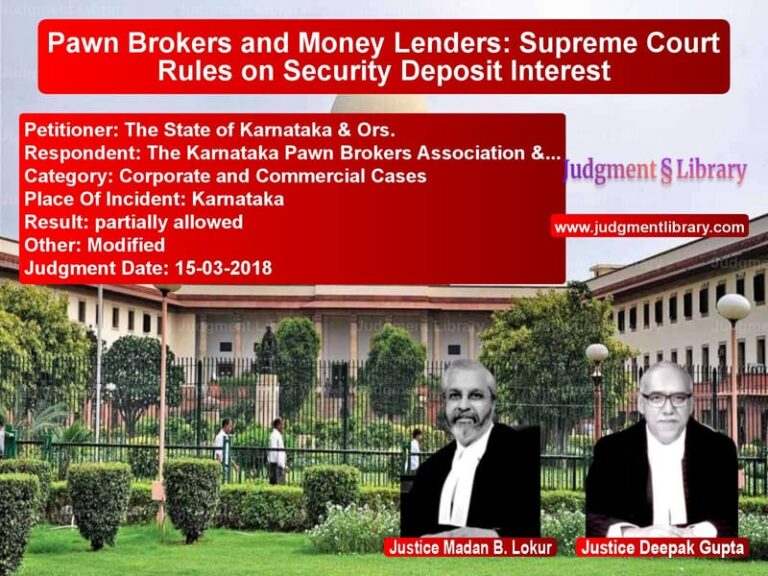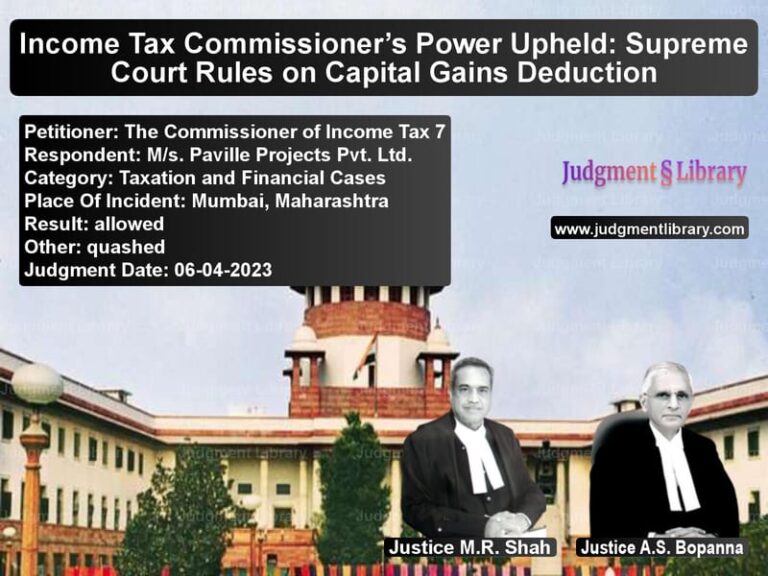Supreme Court Upholds Conviction in Murder Case: Analysis of Common Intention and Eyewitness Testimonies
The Supreme Court of India, in a significant ruling, upheld the conviction of three individuals in a murder case, emphasizing the importance of eyewitness testimonies, common intention, and the correct interpretation of the First Information Report (FIR). The case of Netaji Achyut Shinde (Patil) & Anr. vs. The State of Maharashtra dealt with the brutal killing of a young man, Suhas, in Shivaji Chowk, Osmanabad, and examined the reliability of evidence, delay in lodging the FIR, and the role of medical reports in criminal trials.
Background of the Case
The case originated from a crime committed on July 5, 2011, at Shivaji Chowk, in front of Raviraj Beer Bar in Kallam, Osmanabad. The prosecution alleged that Netaji Achyut Shinde (Patil), Samadhan Shinde, and Balasaheb Kalyanrao Shinde, along with an absconding accused, attacked Suhas with a sword, kicks, and fist blows, leading to his death at the hospital later that evening.
Read also: https://judgmentlibrary.com/joint-liability-in-criminal-law-supreme-court-clarifies-section-34-ipc/
The case was initially heard by the Additional Sessions Judge, Osmanabad, who convicted only Samadhan Shinde (A-2) while acquitting the other two accused, Netaji (A-1) and Balasaheb (A-3), citing lack of direct evidence against them. However, the Bombay High Court reversed this acquittal and convicted all three accused. The matter was then appealed before the Supreme Court.
Arguments by the Appellants (Accused)
- The initial police intimation received at 5:30 PM should be considered the FIR, rather than the one recorded at 11:30 PM, which was allegedly manipulated to falsely implicate the accused.
- The prosecution’s eyewitnesses were partisan and had motives to falsely implicate the accused due to political rivalry.
- The medical evidence did not corroborate the prosecution’s claim that Netaji and Balasaheb assaulted the deceased.
- The dying declaration of the deceased was unreliable, as his injuries should have prevented him from speaking.
- There was no proof of common intention among the accused to commit the murder.
Arguments by the Respondents (State of Maharashtra)
- The eyewitness testimonies of PW-2, PW-3, PW-4, and PW-18 were consistent and clearly established the role of all three accused.
- The police received initial intimation at 5:30 PM, but the detailed FIR was registered at 11:30 PM after the police gathered information and identified the accused.
- The accused actively participated in the attack and shared a common intention, fulfilling the requirement under Section 34 IPC.
- The dying declaration, though not recorded in writing, was corroborated by witnesses who heard the victim naming the accused before succumbing to his injuries.
- The trial court erred in acquitting two accused by giving excessive weight to medical evidence while ignoring strong eyewitness testimonies.
Supreme Court’s Observations
The Supreme Court carefully examined the case, making the following key observations:
- FIR and Delay in Lodging: The Court ruled that the first police intimation received at 5:30 PM was merely an incomplete message and not a formal FIR. The FIR recorded at 11:30 PM was valid and did not indicate any malafide intent.
- Eyewitness Testimonies: The testimonies of PW-2, PW-3, PW-4, and PW-18 were consistent, reliable, and corroborated by material evidence such as blood-stained clothes and forensic reports.
- Common Intention: The accused actively participated in the attack, and their actions demonstrated that they shared a common intention to kill Suhas. The absence of injuries from fist blows or kicks did not diminish their role in the crime.
- Medical Evidence: The Court held that medical reports should not be viewed in isolation but in conjunction with eyewitness accounts and other material evidence.
- Dying Declaration: Though the deceased’s oral statements were not formally recorded, multiple witnesses testified that he named the accused before dying, lending credibility to the prosecution’s case.
The Supreme Court stated:
“Common intention consists of several persons acting in unison to achieve a common purpose, though their roles may be different. Their presence at the crime scene and actions leading to the fatal attack establish beyond reasonable doubt their intent and participation.”
Supreme Court’s Verdict
- The Supreme Court dismissed the appeals and upheld the conviction of all three accused.
- The life sentence awarded to the accused by the High Court was confirmed.
- The Court ruled that the prosecution had successfully proved the accused’s guilt beyond reasonable doubt.
Impact of the Judgment
- Reinforcement of Eyewitness Evidence: The judgment underscores the significance of credible eyewitness testimonies in criminal trials.
- Clarification on FIR and Delays: The ruling clarifies that an incomplete telephonic message does not qualify as an FIR and that reasonable delays in FIR registration do not automatically discredit the prosecution’s case.
- Strengthening Common Intention Doctrine: The judgment provides a clear interpretation of Section 34 IPC, reinforcing the concept that direct physical harm is not necessary to establish common intention.
- Guidance on Medical Evidence: The ruling warns against giving undue weight to medical evidence at the expense of direct eyewitness accounts.
Conclusion
The Supreme Court’s ruling in Netaji Achyut Shinde (Patil) & Anr. vs. The State of Maharashtra sets a precedent for evaluating common intention in criminal cases. By prioritizing reliable eyewitness accounts over speculative defenses, the judgment ensures that justice is served based on the totality of evidence rather than isolated contradictions. The ruling reinforces the principles of fair trial, judicial scrutiny, and the proper interpretation of legal provisions in murder cases.
Read also: https://judgmentlibrary.com/supreme-court-modifies-sentencing-in-karnataka-kidnapping-case/
Petitioner Name: Netaji Achyut Shinde (Patil) & Anr..Respondent Name: The State of Maharashtra.Judgment By: Justice L. Nageswara Rao, Justice Hemant Gupta, Justice S. Ravindra Bhat.Place Of Incident: Osmanabad, Maharashtra.Judgment Date: 23-03-2021.
Don’t miss out on the full details! Download the complete judgment in PDF format below and gain valuable insights instantly!
Download Judgment: netaji-achyut-shinde-vs-the-state-of-maharas-supreme-court-of-india-judgment-dated-23-03-2021.pdf
Directly Download Judgment: Directly download this Judgment
See all petitions in Murder Cases
See all petitions in Attempt to Murder Cases
See all petitions in Bail and Anticipatory Bail
See all petitions in Custodial Deaths and Police Misconduct
See all petitions in Judgment by L. Nageswara Rao
See all petitions in Judgment by Hemant Gupta
See all petitions in Judgment by S Ravindra Bhat
See all petitions in dismissed
See all petitions in supreme court of India judgments March 2021
See all petitions in 2021 judgments
See all posts in Criminal Cases Category
See all allowed petitions in Criminal Cases Category
See all Dismissed petitions in Criminal Cases Category
See all partially allowed petitions in Criminal Cases Category

